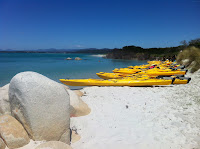After a gruelling third day of the Mark Webber Challenge, team Rexona No Quit is finally reunited. Bruce is driving really fast to get us to the start line in time but his driving is not very smooth with lots of hard braking and turning. On the way to the TA, we passed Salamander’s bay where the day before the swell conditions were terrible for the kayak leg. Today it is flat as. In Eric words: “Yesterday was just f***g bad luck”.
By the time we get off, everyone is feeling sick. Not the ideal. Glenn is keen to be driving from now on. The first leg is a short and fast coastal orienteering run for Glenn and Eric. I will be sitting in the kayak ready to go. I am wearing my beloved Kathmandu Gore-tex jacket and the kayak staff have provided me with a great deck so I can stay dry. I am quite apprehensive with my wound, I cannot afford to get it wet otherwise it could get infected, that would mean going back to the hospital and a definitive end to the race for me. Glenn and Eric arrive and Glenn jumps straight onto the kayak, we are off. I am surprised to find out that it is going well and we are paddling at a pretty good speed. Glenn is definitely happy with our paddling speed.
Thanks to Thuy from Physiowise
who strapped me to ensure I got the maximum support for the paddling leg, which
definitely made a difference.
 |
| Glenn and I paddling together again |
Eric and Glenn are on for a snorkelling leg in icy cold water. With the thermal shock, Glenn has difficulty breathing with the mask but still manage to get the checkpoints and give a smile to the cameras.
 |  |
After the run, the next leg is a bike leg, where our team decides not to do a bike loop where there are optional checkpoints. The trail there is just too narrow and difficult to ride which will slow Glenn and Eric. With hindsight that was a good call to make as team Qantas lost one hour there. At this stage of the race, any mistake is paid cash.
The weather is really hot, the spot paradisiacal with crystal water and if it was not for the race and my injury, I would love to have a swim and a tan on the beach. Our kayak is ready but the wind is becoming a problem. The race directors decide to modify the course and shorten the kayak leg due to the strong wind. Excellent.
 |  |
We paddle across the bay, overtake one team, get close to the beach but suddenly are just not moving very fast in the shallow water. We get off the kayak and Glenn start running to the checkpoint. I have no idea if I will be able to run with the deck, my stitches and wound dressing. I follow him and after 50 meters, trip into a puddle and get drenched. S**t. I can’t assess the damage and if my dressing is still OK, but now there is nothing I can do about it. So I keep running holding my deck, feeling like a bride having to carry her dress around. Hilarious. I start running and we are off to climb the sand dune. We overtake team SOLDIER ON with Mike, a former soldier who got injured in Afghanistan and lost an arm. He is doing the challenge with a prosthetic arm and his team mate Rickie. Very inspiring. We get to the top, dip the dibber at the checkpoint and start running back past the cameras screaming “No quit”.
 |  |
 |  |
As Eric said when we were back in Sydney (check the wrap up video):
“Day 4 was all I wanted to do in Tasmania in just one day.”
Video highlights of the Mark Webber Challenge Day 4:
Rexona No Quit Top Tips:
- Be strategic about your optional checkpoints. When planning, assess how difficult it will be to get them (based on contours, vegetation, etc.), how much time you think you will spend getting them vs. the time credit, and if it might be better to skip them to conserve energy for later. Don’t forget that by the end of the day or after a few legs, you might be stuffed or much slower.
- If unsure, decide the day before that you will make a call on the day. But be clear where and when. The less you need to think on the course, the better.
- Read this great post about "Open Water Swimming for Adventure Racers" that deals with "cold shock response” and how to manage and reduce its effects.
- Having a dry towel and change in the gear box is always useful. Otherwise ensure the host or team mate on standby has some to look after the team when they get back wet.



No comments:
Post a Comment